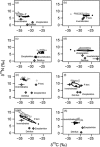Patterns of trophic niche divergence between invasive and native fishes in wild communities are predictable from mesocosm studies
- PMID: 25732893
- PMCID: PMC5098174
- DOI: 10.1111/1365-2656.12360
Patterns of trophic niche divergence between invasive and native fishes in wild communities are predictable from mesocosm studies
Abstract
Ecological theory attempts to predict how impacts for native species arise from biological invasions. A fundamental question centres on the feeding interactions of invasive and native species: whether invasion will result in increased interspecific competition, which would result in negative consequences for the competing species, or trophic niche divergence, which would facilitate the invader's integration into the community and their coexistence with native species. Here, the feeding interactions of a highly invasive fish, topmouth gudgeon Pseudorasbora parva, with three native and functionally similar fishes were studied to determine whether patterns of either niche overlap or divergence detected in mesocosm experiments were apparent between the species at larger spatial scales. Using stable isotope analysis, their feeding relationships were assessed initially in the mesocosms (1000 L) and then in small ponds (<400 m(2) ) and large ponds (>600 m(2) ). In the mesocosms, a consistent pattern of trophic niche divergence was evident between the sympatric fishes, with niches shifting further apart in isotopic space than suggested in allopatry, revealing that sharing of food resources was limited. Sympatric P. parva also had a smaller niche than their allopatric populations. In eight small ponds where P. parva had coexisted for several years with at least one of the fish species used in the mesocosms, strong patterns of niche differentiation were also apparent, with P. parva always at a lower trophic position than the other fishes, as also occurred in the mesocosms. Where these fishes were sympatric within more complex fish communities in the large ponds, similar patterns were also apparent, with strong evidence of trophic niche differentiation. Aspects of the ecological impacts of P. parva invasion for native communities in larger ponds were consistent with those in the mesocosm experiments. Their invasion resulted in divergence in trophic niches, partly due to their reduced niche widths when in sympatry with other species, facilitating their coexistence in invaded ecosystems. Our study highlights the utility of controlled mesocosm studies for predicting the trophic relationships that can develop from introductions of non-native species into more complex ecosystems and at larger spatial scales.
Keywords: freshwater ecosystems; invasive species; stable isotope analysis; trophic niche width; trophic relationships.
© 2015 The Authors. Journal of Animal Ecology published by John Wiley & Sons Ltd on behalf of British Ecological Society.
Figures



Similar articles
-
Predicting the ecological impacts of an alien invader: Experimental approaches reveal the trophic consequences of competition.J Anim Ecol. 2019 Jul;88(7):1066-1078. doi: 10.1111/1365-2656.12996. Epub 2019 May 10. J Anim Ecol. 2019. PMID: 30982964
-
Overlapping niches between two co-occurring invasive fish: the topmouth gudgeon Pseudorasbora parva and the common bleak Alburnus alburnus.J Fish Biol. 2020 Nov;97(5):1385-1392. doi: 10.1111/jfb.14499. Epub 2020 Sep 14. J Fish Biol. 2020. PMID: 33460088
-
Predicting the competitive interactions and trophic niche consequences of a globally invasive fish with threatened native species.J Anim Ecol. 2021 Nov;90(11):2651-2662. doi: 10.1111/1365-2656.13571. Epub 2021 Aug 4. J Anim Ecol. 2021. PMID: 34309851
-
Studying animal niches using bulk stable isotope ratios: an updated synthesis.Oecologia. 2020 May;193(1):27-51. doi: 10.1007/s00442-020-04654-4. Epub 2020 May 11. Oecologia. 2020. PMID: 32393994 Review.
-
Beyond trophic morphology: stable isotopes reveal ubiquitous versatility in marine turtle trophic ecology.Biol Rev Camb Philos Soc. 2019 Dec;94(6):1947-1973. doi: 10.1111/brv.12543. Epub 2019 Jul 24. Biol Rev Camb Philos Soc. 2019. PMID: 31338959 Free PMC article.
Cited by
-
Coexistence mechanisms and individual trophic niche variation between functionally analogous non-native and native carp species.Sci Rep. 2024 Nov 9;14(1):27352. doi: 10.1038/s41598-024-78880-8. Sci Rep. 2024. PMID: 39521870 Free PMC article.
-
Trophic Plasticity of the Invasive Redbelly Tilapia (Coptodon zillii) in China Inferred From DNA Metabarcoding Analysis.Ecol Evol. 2025 Apr 3;15(4):e71118. doi: 10.1002/ece3.71118. eCollection 2025 Apr. Ecol Evol. 2025. PMID: 40190797 Free PMC article.
-
Better Alone Than in Bad Company: Trophic Ecology of Co-Occurring Invasive and Native Crayfish.Ecol Evol. 2025 May 14;15(5):e71385. doi: 10.1002/ece3.71385. eCollection 2025 May. Ecol Evol. 2025. PMID: 40370355 Free PMC article.
-
Invader abundance and contraction of niche breadth during replacement of a native gammarid amphipod.Ecol Evol. 2022 Mar 7;12(3):e8500. doi: 10.1002/ece3.8500. eCollection 2022 Mar. Ecol Evol. 2022. PMID: 35342587 Free PMC article.
-
Changes in phytophagous insect host ranges following the invasion of their community: Long-term data for fruit flies.Ecol Evol. 2017 Jun 7;7(14):5181-5190. doi: 10.1002/ece3.2968. eCollection 2017 Jul. Ecol Evol. 2017. PMID: 28770058 Free PMC article.
References
-
- Andreou, D. , Feist, S.W. , Stone, D. , Bateman, K. & Gozlan, R.E. (2011) First occurrence and associated pathology of Sphaerothecum destruens in cyprinids. Diseases of Aquatic Organisms, 95, 145–151. - PubMed
-
- Baiser, B. , Russell, G.J. & Lockwood, J.L. (2010) Connectance determines invasion success via trophic interactions in model food webs. Oikos, 119, 1970–1976.
-
- Barney, J.N. & Whitlow, T.H. (2008) A unifying framework for biological invasions: the state factor model. Biological Invasions, 10, 259–272.
Publication types
MeSH terms
Substances
LinkOut - more resources
Full Text Sources
Other Literature Sources

